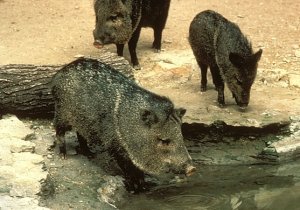 |
| Javelina (straight tusks) |
 |
| Feral Hog (curved tusks) |
You would not think there would be that much difference between the two but it is the little things that make it tough. You have to look at the details. In this case it means looking at the tusks.
 Also, we discussed the aging of deer teeth for quite some time. I found a website that does a great job of explaining this process. Here is a second site. Maybe my students will have time to look at one of these sites before the contest.
Also, we discussed the aging of deer teeth for quite some time. I found a website that does a great job of explaining this process. Here is a second site. Maybe my students will have time to look at one of these sites before the contest. And the last debate was over the wings of waterfowl. We were shown a picture of a duck wing, and had to determine which part of the wing was designated. Here is the picture from the contest and a detailed drawing of the wing.
And the last debate was over the wings of waterfowl. We were shown a picture of a duck wing, and had to determine which part of the wing was designated. Here is the picture from the contest and a detailed drawing of the wing. After we went over these specimens, Sean did a presentation on javelina. He did a great job!
Javelina

In Texas, the javelina is found in the more arid or semi-arid parts of the state, with most occurring in the South Texas brush country, the Trans-Pecos' desert grasslands, and the Edwards Plateau's oak-juniper woodlands.
Group Behavior
•Javelina are herd animals, found in groups of 2-20 individuals, with 54 being the record sighting.
•These herds are usually comprised of close-knit family groups.
•Herds maintain a territory, which varies in size based upon food and cover availability. They defend the interior of these areas against all other javalina intruders, but other groups are tolerated along the perimeters.
•Javelina herds can cover a territory of from 1000 to 2000 acres
•Herds will consist of all age classes and both sexes. The sex ratio is typically 1:1, but the dominant male is usually the only male to do any breeding.
Breeding and Caring for Young
•The promiscuous male becomes sexually mature at about 1 year old.
•The female may mature as early as 8 months old, or as late as 14 months.
•A normal litter consists of 2 young, but may be 1-6. Gestation is 141-151 days.
•Young javalina may be born at any time of the year, but the peak of breeding activity in Texas seems to be the winter months.
•The female will leave the herd for just 1 day to give birth.
•The babies are able to follow their mom within a couple of hours, and they rejoin the herd soon after.
•Birth normally comes in a den made from a hollowed log, a rock crevice, or a hole in otherwise super dense brush.
•Older sisters of the babies often nurse them once the mom and young return to the herd.
•Weaning occurs at about 6-8 weeks but the young stay at mother's side for up to 3 months.
Diet
•The javelina is omnivorous, meaning it will eat just about anything that doesn't eat it first.
•About 60% of the javalina’s normal diet is nothing but prickly pear cactus, sometimes up to 95%
•They are true cud chewers, equipped with a three compartment, complex stomach, designed to break down foods high in cellulose content, like cactus, grass, roots, nuts and tubers, mesquite beans, lechuguilla, sotol, mast, fruits, and insects.
Cover
•Javelina prefer semi-desert conditions
•Dense thicket of brush, prickly pear or scrub oak
•Rough canyons and gullies for travelways and protection during inclement weather
•Most active during cooler hours with resting areas in denser thickets, under rock ledges, or other shady areas
Life Span
Adult javelina live to be about 15 years or more, and 1 individual in captivity made it to 24 years.
Land Management
•Brush management/range rehabilitation
•Retain 30-50% of rangelands in brush patterns (strips, motts, and draws)
•Feeding loafing and bedding areas should be joined by brush strips or brushy drainageways
•Dense brushy and prickly pear areas should be preserved
•Their succulent diet makes javelina less dependent on water.
•Javelinas seek water in streams, livestock ponds and troughs when prickly pear is not available
•If prickly pear and lechuguilla have been reduced through brush control, water replacement is necessary.
Plants on the Contest
•Agarito
•Honey Mesquite
•Live Oak
•Pecan
•Persimmon
•Prickly Pear
No comments:
Post a Comment